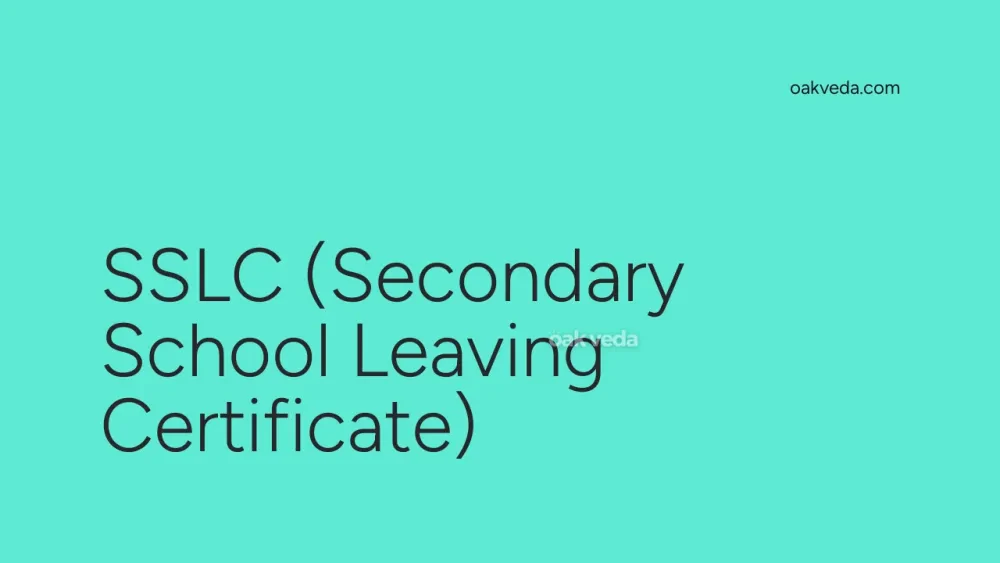
What is the Full Form of SSLC?
The full form of SSLC is Secondary School Leaving Certificate. This important credential marks the completion of secondary education in several Indian states and holds significant value in the country's educational system.
What is Secondary School Leaving Certificate?
The Secondary School Leaving Certificate, commonly known as SSLC, is a qualification awarded to students upon successfully completing their secondary education, typically after the 10th grade. It serves as a crucial milestone in a student's academic journey, opening doors to higher education and various career opportunities.
Origin and Development of Secondary School Leaving Certificate
The concept of SSLC has been an integral part of the Indian education system for many decades. It was initially introduced to standardize the assessment of students completing their secondary education. Over time, the SSLC examination has evolved to meet changing educational needs and standards.
In the past, when birth registration was not mandatory in India, the SSLC certificate played a vital role as a primary form of proof for an individual's date of birth. Even today, for those born before 1989, the SSLC certificate remains a valid document for verifying one's date of birth for official purposes.
How does Secondary School Leaving Certificate work?
The SSLC examination is typically conducted by state education boards at the end of the 10th grade. Students are assessed on various subjects, including languages, mathematics, sciences, and social studies. The examination tests the knowledge and skills acquired during their secondary education.
Upon successfully passing the SSLC examination, students receive their Secondary School Leaving Certificate. This document contains important information such as the student's personal details, subjects studied, marks obtained, and overall grade or percentage.
Functions of Secondary School Leaving Certificate
The SSLC serves several important functions in the Indian education and employment landscape:
-
Educational Progression: It acts as a gateway for students to pursue higher secondary education or pre-university courses.
-
Skill Development: For those opting for vocational training, the SSLC is often a prerequisite for admission.
-
Employment Opportunities: Many entry-level jobs require candidates to have completed their SSLC as a minimum qualification.
-
Identity Verification: The SSLC certificate is often used as a valid identity and age proof document.
Applications of Secondary School Leaving Certificate
The SSLC certificate finds applications in various areas:
-
Academic Pursuits: It is essential for admission to higher secondary education or diploma courses.
-
Job Applications: Many employers require candidates to submit their SSLC certificate as proof of basic education.
-
Government Services: For certain government jobs and services, the SSLC certificate is a mandatory document.
-
Passport Applications: The SSLC certificate is accepted as a valid document for date of birth verification during passport applications.
Features of Secondary School Leaving Certificate
Key features of the SSLC include:
-
Comprehensive Assessment: It provides a holistic evaluation of a student's performance across various subjects.
-
Standardized Format: The certificate follows a standardized format, making it easily recognizable and verifiable.
-
Official Recognition: SSLC is widely recognized by educational institutions and employers across India.
-
Multilingual: In many states, SSLC certificates are issued in both English and the regional language.
Benefits of Secondary School Leaving Certificate
The SSLC offers several benefits to students:
-
Educational Opportunities: It qualifies students for admission to higher secondary education or vocational courses.
-
Career Pathways: SSLC opens up various career options, including diploma courses and entry-level jobs.
-
Skill Recognition: It formally recognizes the skills and knowledge acquired during secondary education.
-
Personal Development: The process of preparing for and completing the SSLC examination contributes to a student's overall development.
Limitations or Challenges of Secondary School Leaving Certificate
While the SSLC is a valuable credential, it does have some limitations:
-
Regional Variations: The syllabus and examination pattern may vary across different states, potentially creating challenges for students moving between states.
-
Pressure on Students: The importance placed on SSLC results can create significant stress for students.
-
Limited Scope: While it's a crucial milestone, SSLC alone may not be sufficient for many advanced career paths in today's competitive world.
Future Developments in Secondary School Leaving Certificate
The education system in India is continuously evolving, and so is the SSLC:
-
Digital Certificates: Many states are moving towards issuing digital SSLC certificates for easier verification and storage.
-
Skill-based Assessment: There's a growing emphasis on incorporating skill-based assessments in addition to traditional subject-based examinations.
-
National Standardization: Efforts are being made to standardize secondary education across the country, which may impact the SSLC system in the future.
FAQs on SSLC Full Form
-
What educational opportunities are available after SSLC? After SSLC, students can pursue higher secondary education (11th and 12th grade), join vocational courses, or enroll in polytechnic diploma programs.
-
Is SSLC equivalent to 10th grade in all Indian states? While SSLC is equivalent to 10th grade in many states, some states may have different terminology or systems for secondary education completion.
-
Can SSLC be used as a proof of age? Yes, especially for individuals born before 1989, the SSLC certificate is often accepted as a valid proof of age for official purposes.
-
How important is SSLC for future career prospects? SSLC is crucial as it's often the minimum educational requirement for many jobs and is necessary for pursuing higher education.
-
Can students who have completed SSLC apply for international studies? While SSLC is recognized in India, for international studies, students typically need to complete higher secondary education (12th grade) and may need to take additional standardized tests.
You may be interested in:
- Mbps (Megabits Per Second): Full Form Explained
- JAIIB (Full Form): Junior Associate of Indian Institute of Bankers
- CTC (Cost To Company): Full Form and Explanation
- HVAC (Heating, Ventilation, and Air Conditioning)
- SAP (Systems Applications and Products) Full Form
- ICT (Information and Communications Technology)

